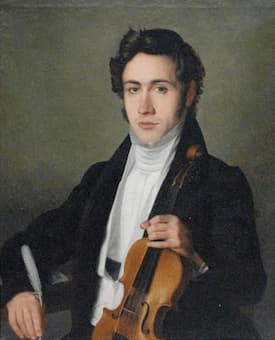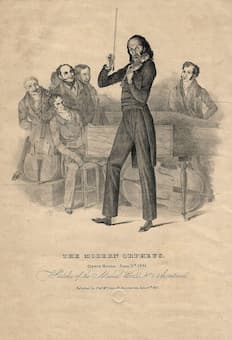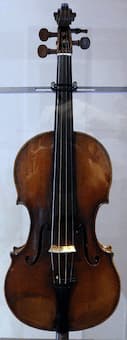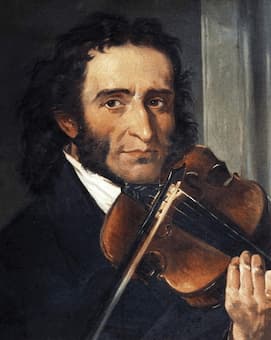
Niccolò Paganini
For almost 20 years, Niccolò Paganini had patiently confined his concert activities to Italy before setting out to conquer various European capitals. Initially he appeared in Vienna and Franz Schubert excitedly reported, “We will never hear his like again!” He played 11 concerts in Berlin, and he performed for Goethe in Weimar. Mightily impressed, the poet stated, “I have heard something meteoric.”

Richard James Lane: The Modern Orpheus (1831)
In April 1830, a young and ambitious Robert Schumann travelled to Frankfurt to hear the famed violinist. “How he cast his magnetic chains into the listeners lightly and invisibly,” Schumann writes, “so that the latter swayed from one side to the other!” Paganini was to become a member of Schumann’s imagined League of David against the Philistines, and makes a famed musical appearance in Carnaval. Two weeks later, on 26 April 1830, Paganini gave the first performance of his Violin Concerto in D minor, written the previous year. Louis Spohr, was a slightly younger contemporary of Beethoven and the only real contender to Paganini as a violin virtuoso. After hearing Paganini perform the 4th concerto he wrote “His left hand, and his constantly pure intonation were to me astonishing. But in his compositions, and his execution I found a strange mixture of the highly genial and childishly tasteless, by which one felt alternately charmed and disappointed, so that the impression left as a whole was, after frequent hearing, by no means satisfactory to me.”
Niccolò Paganini: Violin Concerto No. 4 in D minor “Allegro maestoso”
 During an earlier concert tour to Italy, Spohr had personally met Paganini and recorded his impressions in his autobiography. He writes, “Yesterday Paganini called on me the morning, and so I have at length made the personal acquaintance of this wonderful man, of whom since I have been in Italy I have heard some story or other every day. No instrumentalist ever charmed the Italians so much as he… On making nearer enquiry, what it is that he in reality fascinates his auditory with, one hears from the non-musical portion the most exaggerated encomiums—that he is a complete wizard, and brings tones from his violin which were never heard before from that instrument. Connoisseurs, on the other hand, say that it cannot be denied he certainly possesses a great dexterity with the left hand, in double-chords and in passages of every kind, but that the very thing by which he fascinates the crowd debases him to a mere charlatan, and does not compensate for that in which he is utterly wanting—a grand tone, a long bow-stroke, and a tasteful execution… I should much like to hear Paganini play in his peculiar manner, and the more so, because I presume that so admired an artist must possess some more real merits than those adverted to.”
During an earlier concert tour to Italy, Spohr had personally met Paganini and recorded his impressions in his autobiography. He writes, “Yesterday Paganini called on me the morning, and so I have at length made the personal acquaintance of this wonderful man, of whom since I have been in Italy I have heard some story or other every day. No instrumentalist ever charmed the Italians so much as he… On making nearer enquiry, what it is that he in reality fascinates his auditory with, one hears from the non-musical portion the most exaggerated encomiums—that he is a complete wizard, and brings tones from his violin which were never heard before from that instrument. Connoisseurs, on the other hand, say that it cannot be denied he certainly possesses a great dexterity with the left hand, in double-chords and in passages of every kind, but that the very thing by which he fascinates the crowd debases him to a mere charlatan, and does not compensate for that in which he is utterly wanting—a grand tone, a long bow-stroke, and a tasteful execution… I should much like to hear Paganini play in his peculiar manner, and the more so, because I presume that so admired an artist must possess some more real merits than those adverted to.”
Niccolò Paganini: Violin Concerto No. 4 in D minor “Adagio”

Bartolomeo giuseppe guarneri, violino cannone, appartenuto a niccolò paganini, cremona 1743
In a subsequent meeting Spohr and his friends urged Paganini to play something. “But he very bluntly refused… Afterwards, when we were alone, and I again besought him, he said, his style of play was calculated for the great public only, and with them never failed in its effect; and that if he was to play anything to me, he must play in a different manner, and for that he was at the moment by no means in the mood.” Spohr was probably more gifted than Paganini in terms of his greater diversity of compositions and his ability for instrumental arrangement, but Paganini’s audacious technique was unquestionable.
 Critics write, “Spohr had more understanding of balance and composition while Paganini had the required demonic virtuosity for the solo violin that Spohr’s own genius simply could not surpass.” Paganini’s D-minor concerto is a more lyrical work than its predecessor, and the composer closely guarded the manuscript. After Paganini’s death, the work was handed down to his heirs, and sold to a paper dealer in 1936. That orchestral score was subsequently sold to the musicologist Natale Gallini, but the solo violin part was unaccounted for. Gallini searched far and wide for the missing part, and eventually found it in a collection of music that had belonged to Giovanni Bottesini, the famous double-bass virtuoso. Gallini completed the musical score and passed it to his son, the conductor Franco Gallini. With Arthur Grumiaux on the violin, the work received its second world premiere on 7 November 1954.
Critics write, “Spohr had more understanding of balance and composition while Paganini had the required demonic virtuosity for the solo violin that Spohr’s own genius simply could not surpass.” Paganini’s D-minor concerto is a more lyrical work than its predecessor, and the composer closely guarded the manuscript. After Paganini’s death, the work was handed down to his heirs, and sold to a paper dealer in 1936. That orchestral score was subsequently sold to the musicologist Natale Gallini, but the solo violin part was unaccounted for. Gallini searched far and wide for the missing part, and eventually found it in a collection of music that had belonged to Giovanni Bottesini, the famous double-bass virtuoso. Gallini completed the musical score and passed it to his son, the conductor Franco Gallini. With Arthur Grumiaux on the violin, the work received its second world premiere on 7 November 1954.
For more of the best in classical music, sign up to our E-Newsletter
Niccolò Paganini: Violin Concerto No. 4 in D minor “Rondo galante”
